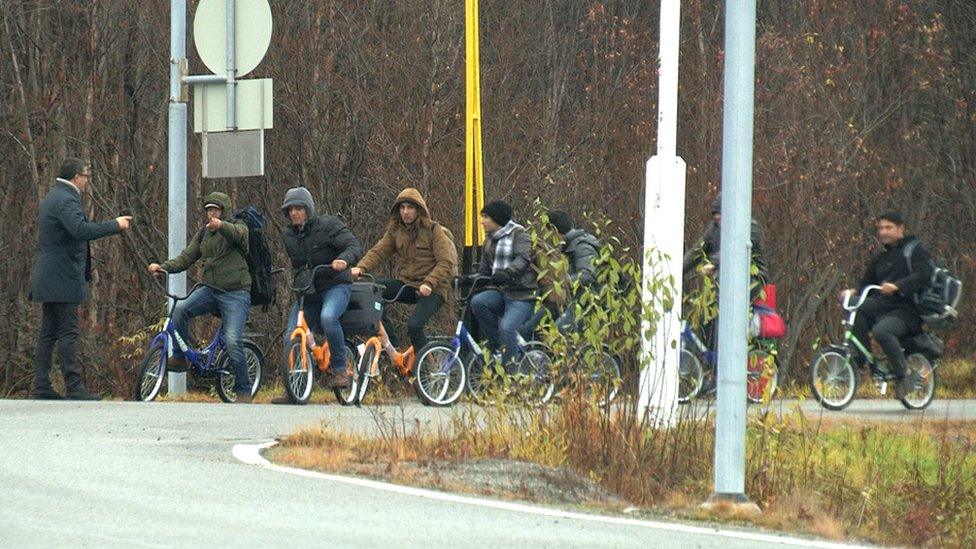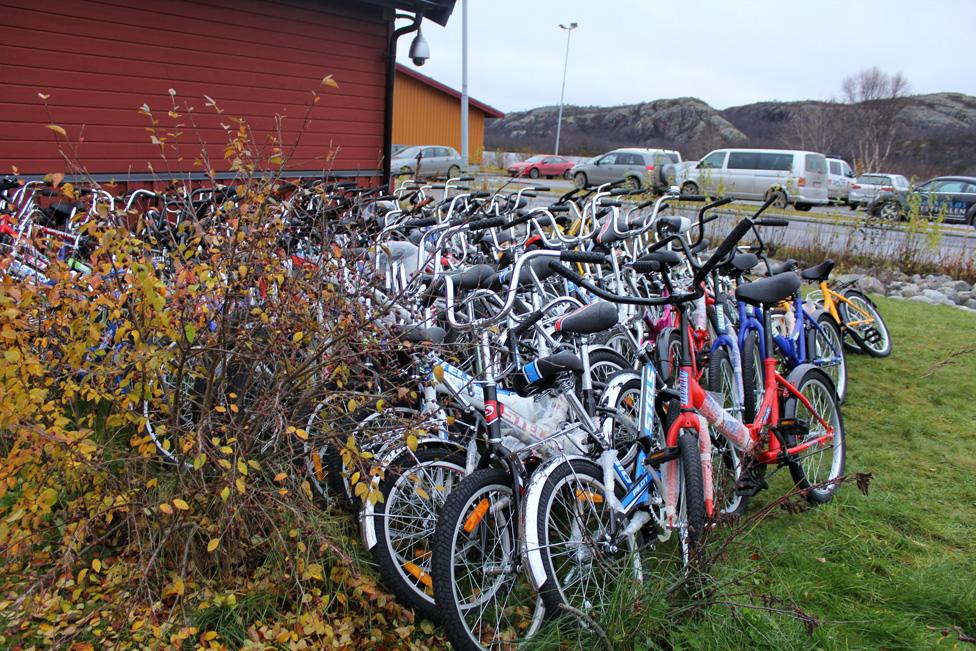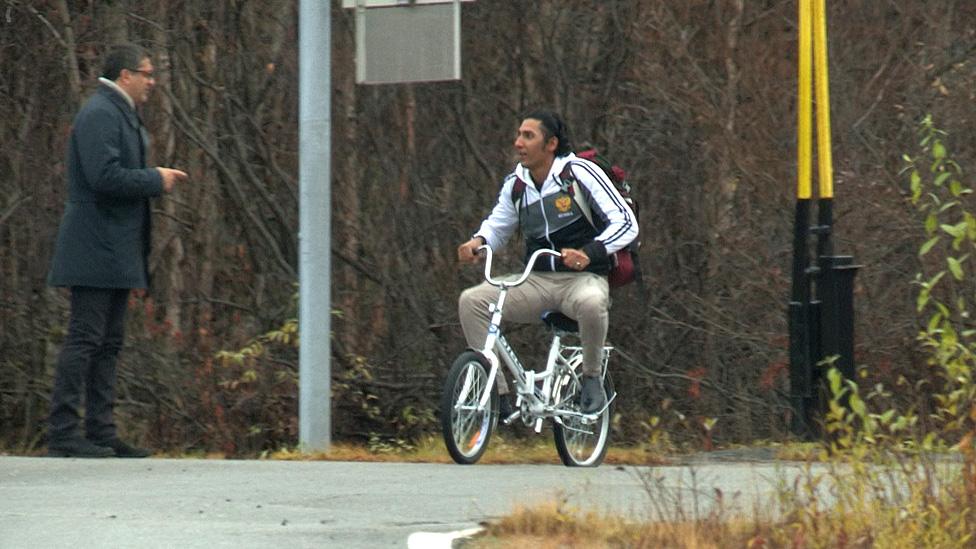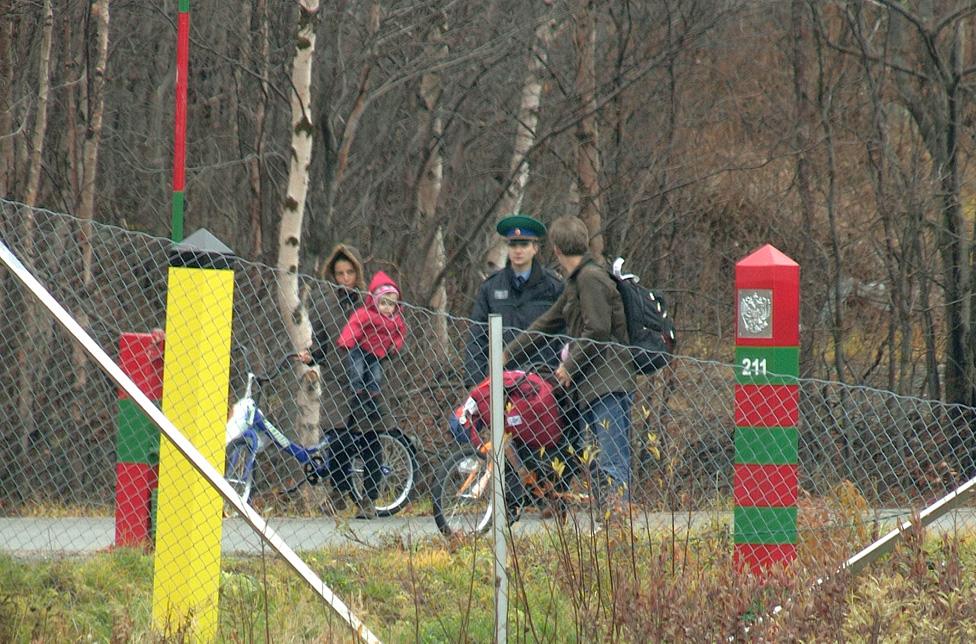Seeking asylum on children's bicycles
- Published

Hundreds of migrants have cycled into Norway from Russia after finding a new route into Europe that avoids the deadly Mediterranean crossing. They are not allowed to cross the Arctic border on foot, so a lucrative trade in bicycles has opened up, with migrants buying bikes and pedalling the final few metres.
Fahed half squats and uses the palm of his hand to show me the height of the bicycle he rode across Russia's border with Norway. At full height he is about 5ft 10in tall but the hand he is gesturing with is about level with his knee.
"You rode a children's bicycle?" I ask.
"Yes, yes," He replies. "One for kids."
He smiles and then starts to laugh before taking another drag on his cigarette. He is from Algeria and speaks in broken English. He is one of an increasing number of migrants travelling overland into Russia and then north into the Arctic Circle to the point where the borders meet. In the whole of 2014 just seven asylum seekers crossed over the Storskog border crossing. In October alone there have been 1,100. Some are from Iraq, Afghanistan and Lebanon but most are from Syria.
They need a bicycle because the Russian authorities don't let people cross the Russian border on foot. Under Norwegian law, it is illegal for a driver to carry people into the country without the proper papers.

Fahed tells me he paid $200 (£130) for his bike when he arrived in Murmansk. He looks pleased with himself when he adds that the price included the taxi ride up to border crossing point - what he described as a "package deal". It's then that he made his one and only journey on his new purchase - cycling just 120m (130 yards) across the no-man's land between Russia and Norway.
Not taking into account the cost of the taxi ride, that works out at $1.60 per metre - probably one of the most expensive journeys in the world. But he has no regrets. He says it's a "small price to pay" to get to Europe.
All the asylum seekers are temporarily housed in the small nearby town of Kirkenes, which is hastily having to build a new reception centre to accommodate 500 more people.
The authorities take them from the border to the town by bus, so the bicycles get left behind at the border.

Most were made for children. A hundred or so are neatly stacked against the back wall of the border police's customs office, and these are just the bikes that have been collected over the past two days. Many are brand new. There's not a speck of rust on the chrome handle bars. Some still have protective bubble wrap on the frames, presumably from the factory where they were made, to stop them getting scratched.
What little sunlight there is bounces off the massed ranks of reflective mud guards. But this is a bicycle graveyard. Every two or three days they are collected up, taken away and crushed. It seems like a terrible waste - until the chief of the border police Stein Hansen takes a pair of handle bars in his bare hands, and with very little effort twists them into a u-shape.
He wishes the bicycles could be put to some use, he says, but by Norway's standards they are not fit for the road.

There's something slightly comical about seeing men on bicycles that are way too small for them.
Once they pass a red and green striped marker post, they are officially out of Russia. Freewheeling for a few more feet past the yellow barrier, they make it into western Europe.

As I watch, a young family appears, laden with luggage and carrying a baby. Exceptions can be made to the "no walking rule", it appears, as both the mother and father are on foot. Presumably their precious cargo gives them special dispensation.
However, each of them is also wheeling a bicycle with their free hand, so presumably this makes them cyclists and not pedestrians in the eyes of the law.
The reality is right now none of them care how absurd the rules are, nor how strange this looks.
The authorities here believe the numbers coming over can only grow.
Although the cold, wet landscape couldn't be more different than from the ones the migrants left behind, this Arctic road stays open, even in winter. Meanwhile the Mediterranean route - never safe - becomes even stormier.

Subscribe to the BBC News Magazine's email newsletter, external to get articles sent to your inbox.